When Britain entered the First World War in August 1914 the Chief Scout Sir Robert Baden Powell urged Scouts to get involved to support the war effort, not as combatants but rather filling useful roles at home thereby freeing men to enlist and go to the Front. His appeal was backed up by a poster campaign reinforcing the message of service, as can be seen in the example below. Thousands of boys and young men answered the call, with many joining the Scouts for the first time in the Autumn of 1914.
One such local man who did so was Joe Braddock, who lived with his family in Stockport Road. Joe’s name will already be known to many local people through the researches of Peter Clarke, Andy Cook and Jon Bintliff, who have given details of all the Marple servicemen killed in the First War in their book Remembered, published in 1999.
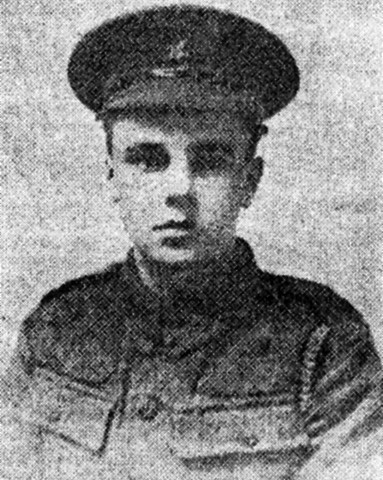 |
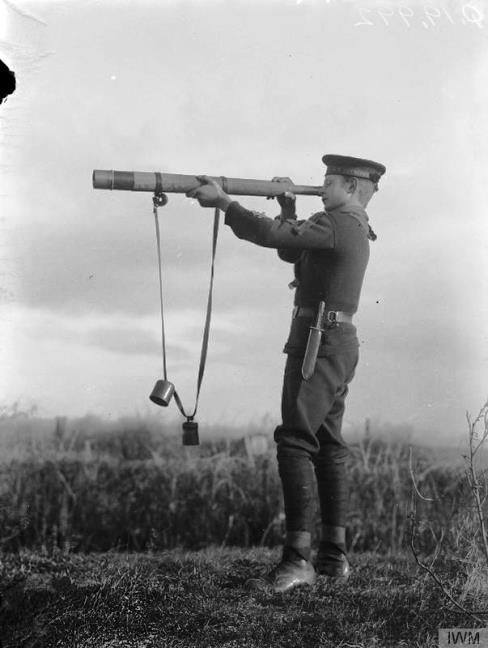 |
Left: Joe Braddock | Right: A Sea Scout on lookout duties First World War [Image courtesy of Imperial War Museum ©]
Joe's 1915 Scouting Diary found its way back to Marple after being purchased on ebay by Mark Whittaker. After photographing it Mark gave the diary to Andy Cook. Andy in turn passed it to Peter, who has kindly donated it to the Marple Local History Archives.
Joe's Diary forms the basis of the present article:
The diary is not a daily journal. Joe kept it in much the way that most of us use a pocket diary, writing in reminders and noting events of importance to the owner like trips and , in Joe’s case, sporting events. From these snatches of information, we can build a picture of Joe’s life in the last full year before his fateful military service began.
When war broke out, Joe was 17, just too young for active service. He joined Marple Scouts and threw himself into the routine with enthusiasm. By December 1914, Joe had passed his Tenderfoot tests and in the following three months passed a further series of tests to become a Scout Second Class.
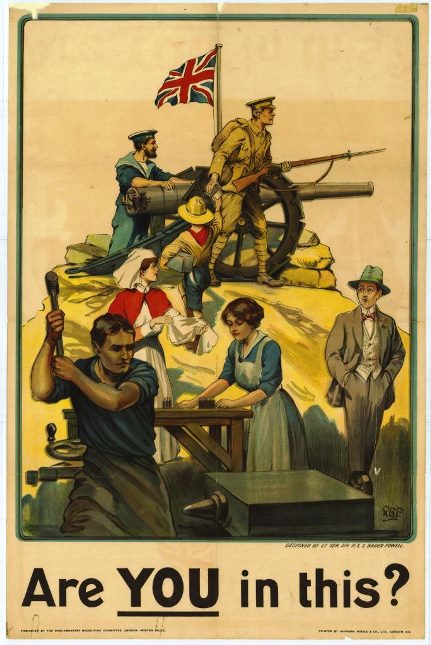
Government poster from 1914 promoting civilian action to support the Armed Services with a Scout in a prominent position [© The Scout Association Heritage Collection]
These include a signalling test, a skill that was to figure greatly in the remaining years of his short life. By May, he had passed two elements of the tests needed to gain Scout First Class status. By the Summer of 1915 , however, Joe was apparently becoming unsettled in the Marple troop and in July 1915 he obtained a transfer to High Lane Scouts. The reasons for this move are not entirely clear. Two or three cryptic entries in the Diary from around this time suggest that he was not happy with the way the Marple troop was being run. More positively, the High Lane troop had a Sea Scouts branch which attracted Joe. Pages 64 and 65 of his Diary outlined instructions from the Admiralty for Sea Scouts in Coast Watching. Having read this information, it seems Joe had already decided on a more active involvement in the war effort by undertaking these duties. He enthusiastically set about making his mark at High Lane, quickly passing a further series of tests, again including signalling but also photography another of his interests. On the 14th August, he records that he had made the decision to go on coast guard duty. In the following fortnight he obtained the agreement of his family and the Scouts to go and prior to his departure he was made a Patrol Leader for the Sea Scouts and passed his First Class Signalling badge. On 27th August he left work early, packed his bags, having made a list in the back of the Diary of what he should take with him and went to catch the night train for the long journey south to Cornwall to take up his duties with other scouts on the Lizard Peninsula. His train went via Bristol to the Cornish station Gwinear Road [closed in the Beeching cuts of the 1960s] from where he journeyed onto Helston, arriving in time for afternoon tea.
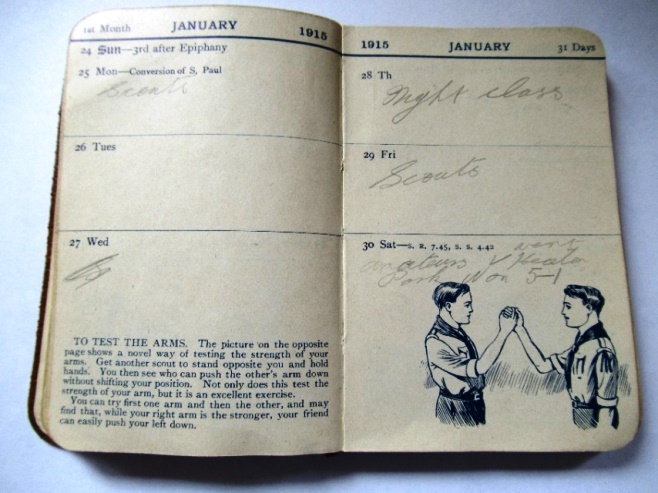
A typical page from Joe’s Diary with the daily tip for Scouts and some of Joe’s jottings
The volunteer scouts were under the supervision of the local Coastguards and the general authority of Board of Trade inspectors. There was a fear of a possible German invasion, so an important aspect of the scouts’ work was to keep a watch for enemy shipping. Other duties included watching out for any ship in distress and taking and receiving messages on behalf of the Coastguard. To carry out these duties the scouts were divided in to two groups each taking a separate “beat” with the day divided into a series of naval-type watches. Joe summarised his duties in the diary but he appears not to have had the excitement of observing the enemy; the only military ships he noted were Royal Navy vessels, including one of the formidable Dreadnoughts. He continued to develop his signalling skills, including Morse Code which he practised in the diary. Of course, life in Cornwall was not all duty and work. Joe was able to continue his love of playing football against some local teams and several times he took the opportunity to bathe in the sea. Other diversions included a trip to Penzance, regular visits to Band of Hope meetings and once a trip out in the local Lifeboat.
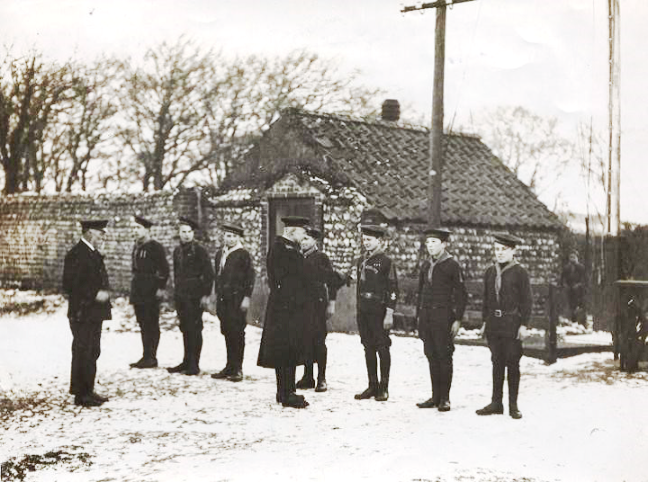
An inspection of volunteer sea scouts on coast watching duty during the winter of 1914/15 [© The Scout Association Heritage Collection]
In December 1915, he was granted seven days’ leave to return home to Marple for Christmas. Having had an enjoyable time with visits to the cinema and the theatre, he returned to the Lizard on 29th December. The last entry in the Diary records that he went to a Bazaar in one of the local schoolrooms on New Year’s Day, 1916. While we have no diary for that year, we know from other sources that later in 1916 Joe decided to take a more active role in the war effort and enlist in the Army. He did so whilst in Cornwall, initially joining the South Lancashire Regiment, which had bases in the West Country, but soon transferring to a service battalion of the Gloucestershire Regiment as a Signaller. A huge number of transfers occurred in 1916 as thousands of volunteers poured into the New Armies and existing Battalions were re-formed after the heavy losses on the Western Front in 1915. In Joe’s case the Diary provides information explaining this particular transfer.
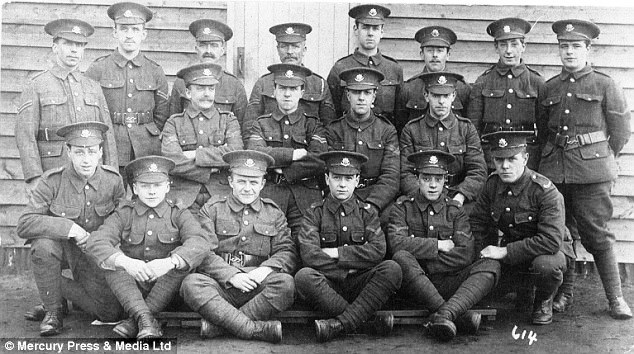
A Birkenhead Bantam Platoon
The 14th Battalion of the “Glosters” was a newly formed Bantams battalion, specifically recruiting men whose stature would have previously rendered then ineligible for military service as they fell below the minimum required height of 5ft. 3ins. Given the desperate need for men, this minimum height was reduced to 5ft. and the Glosters recruited heavily for the new battalion throughout the West Country in 1915 and early 1916 with posters like the one below. In Joe’s Diary there was a page for “Personal Memoranda” which he duly filled in, revealing that he was 5ft in height and weighed just 6st. 2lbs. No doubt he was still growing; his boot size has a 4 crossed out and replaced with a 5, but his height made him a perfect recruit for the Bantams. We know that Joe enlisted in 1916 whilst serving at the Lizard but unfortunately other details are missing as his full service record was one of the many destroyed by enemy bombs and fire during the Second World War.
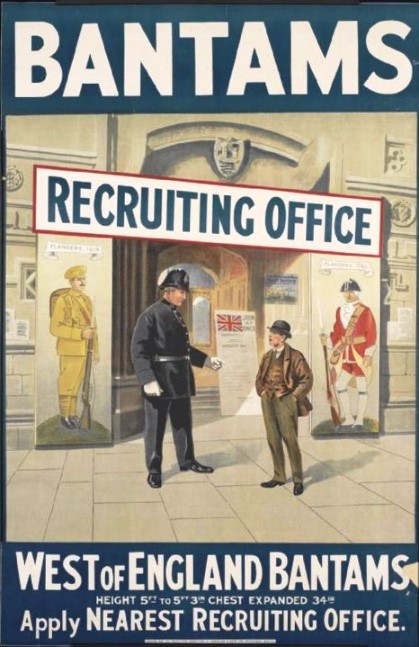
Joe will have seen this or a similar poster while in Cornwall, encouraging him to enlist and don the service uniform
Later in 1916 Joe left for France with his Battalion, which was one of the earliest Bantam outfits to be formed. In October, 1917 Joe was killed by an artillery shell in what became known as the Battle of Passchendaele. His mother received the tragic news at the family home in Albert Buildings, 129-131 Stockport Road, in the centre of Marple. The photos below show a section of Stockport Road in 1911 with Joe’s home in the buildings in the near foreground and the present day view of the section, opposite the current Costa Coffee, with the datestone clearly visible.
After his death, Joe was buried in Bedford House, a War Graves Cemetery in Belgium. However, his name is also remembered on the Marple War Memorial and on a Methodist Church Plaque, while the family had his name added to the family gravestone in All Saints Churchyard as shown below [photograph courtesy of Hilary Atkinson]
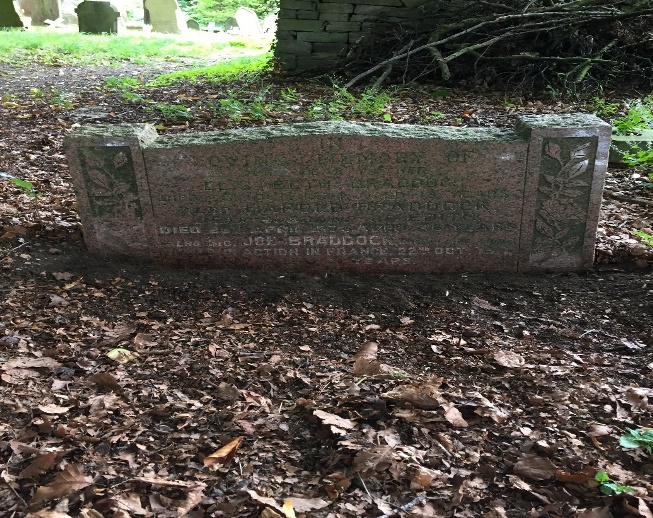
Braddock Family Gravestone in All Saints Churchyard
Joe’s diary is interesting to us in three ways. First, it gives us a highly personal glimpse of a young man’s life at a crucial time in the country’s history. Secondly, it is a useful part of the history of scouting at “grassroots level” and life on the “Home Front” during the Great War and thirdly, more widely, it gives us a flavour of the age, its priorities and outlooks so different from our own a century later. The diary is a valuable addition to our Archive, for which we are grateful to Peter Clarke, and it is hoped that similar donations of interesting documents and other ephemera might be offered in the future.
Geoff Higgins (August 2020)
Author’s endnote: I am most grateful to Hilary Atkinson for encouraging me to write this article and to her and Neil Mullineux for helpful advice on the contents and layout of the article.
______________________
Joe Braddock : A Postscript
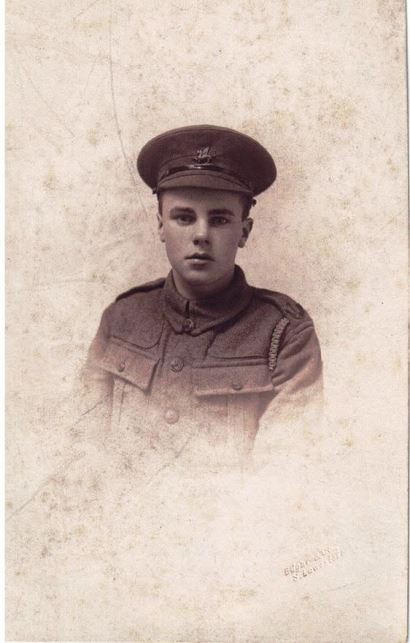
An article appeared in a previous Newsletter about Joe Braddock, one of Marple’s young men killed in the First World War. The article was read by Mr. David Bolsover of Chapel en le Frith who identified himself as the grandson of Joe Braddock’s brother Harold. Thus, if Joe had lived David would have been his great nephew. David contacted the History Society to say that he had other family documents relating to Joe’s death in action and that he was prepared to share this information with interested members of the Society. Consequently, copies of the documents were sent to the author of the original article and, on examination, it was clear that they provided further interesting if poignant details relating to Joe’s death. This postscript to the original article is based upon this fresh information.
Joe was killed on 22nd October 1917 during the Battle of Passchendaele. Three weeks previously he had written a letter home to a friend, Will, which was probably his last communication from the Front and hence retained by the family as a treasured possession. Understandably, the letter is full of information about casualties and the loss of men who were mutual acquaintances of Joe and Will. In the simple sentences one can detect the anxiety and war-weariness that most of the soldiers would have felt; Joe can’t hide, for example, his envy that Will had been moved back to England, albeit due to some unspecified injury or illness. Yet amongst all the talk of death and hardship, Joe was still able to express some hope and glimmers of cheer. He explained that his section had been removed from the front line for a few days rest; even better, the small village to which they had been withdrawn had had some rest facilities established there for the troops, including a cinema and a YMCA. Above all, Joe had the prospect of leave and was hoping to be home in about two months’ time. Unfortunately, he was not to survive that long.
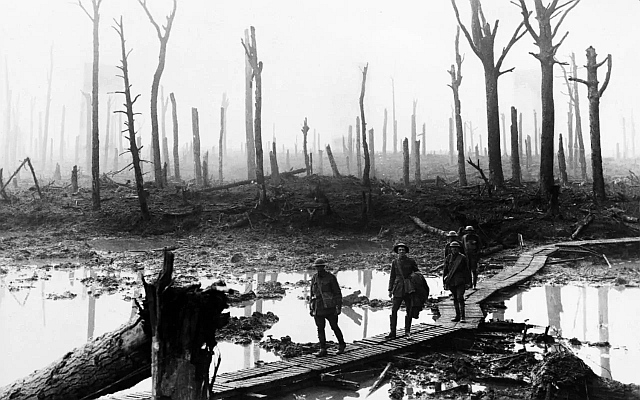
Battle of Passchendaele
Joe’s mother received official notification of his death from the War Office, by way of the Infantry Records Office [IRO], in a letter dated 5th November 1917. It is possible she already knew of his death by then as one of Joe’s comrades, a Private G.J. Nicholls, wrote to her telling her of Joe’s death and giving some details of the circumstances. This letter which was published in the local newspaper in the notice of Joe’s death and reprinted in Peter Clarke’s book Remembered about Marple’s First War dead, was dated 24th November but it is not known when it was received. The family’s grief and sense of loss must have been compounded when just five days after the IRO letter a stark notification dated 10th November was sent to his mother by the Regimental Paymaster stating that “the separation allowance and allotment of pay” would cease from the date of notification of his death.
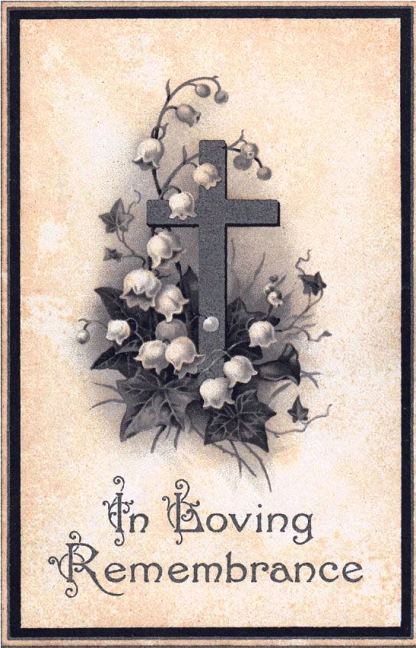 These terse official documents of course brought no sense of closure for Joe’s family. They knew little about his death, had no idea where his remains might be and had received no effects or momentos of his service career. Subsequent documents held by David Bolsover make clear, however, that the family especially his mother and brother Harold were determined to find out more. In February 1918 Joe’s mother wrote to the Army to ask whether Joe had made and deposited a will [as many soldiers at the Front did] but she received a reply from the IRO a week later to say that no will existed. Next the family set about trying to discover where Joe had been buried and whether any of his effects had been collected by colleagues. Again, the information forthcoming was disappointing. A letter from the War Office in March 1918 confirmed that the place of Joe’s burial had not been located. Meanwhile Joe’s brother Harold made further enquiries about Joe’s effects only to receive a letter in June explaining that the IRO had been instructed to pass on any effects to the family but that if Harold had not heard from them it regretted that no effects had been salvaged “due to the conditions of Modern Warfare”.
These terse official documents of course brought no sense of closure for Joe’s family. They knew little about his death, had no idea where his remains might be and had received no effects or momentos of his service career. Subsequent documents held by David Bolsover make clear, however, that the family especially his mother and brother Harold were determined to find out more. In February 1918 Joe’s mother wrote to the Army to ask whether Joe had made and deposited a will [as many soldiers at the Front did] but she received a reply from the IRO a week later to say that no will existed. Next the family set about trying to discover where Joe had been buried and whether any of his effects had been collected by colleagues. Again, the information forthcoming was disappointing. A letter from the War Office in March 1918 confirmed that the place of Joe’s burial had not been located. Meanwhile Joe’s brother Harold made further enquiries about Joe’s effects only to receive a letter in June explaining that the IRO had been instructed to pass on any effects to the family but that if Harold had not heard from them it regretted that no effects had been salvaged “due to the conditions of Modern Warfare”.
In the face of these disappointments the family did not give up. Further requests regarding the location of Joe’s burial in 1921 again met with no positive response. Still the family persisted with further correspondence and at last in June 1923 they met with some success. The IRO wrote to Mrs Braddock enclosing Joe’s identity disc which had been found, no doubt during the operations to consolidate the graves of the war dead in France and Belgium. The letter also stated that further enquiries about Joe’s burial place should be addressed to the War Graves Commission [WGC]. Later that month the Commission was able to give the family the information they had been seeking for over five years.
The letter stated that, as part of the general consolidation of war cemeteries, Joe’s remains had been exhumed from “a point north of Langemarck, due north of Ypres”, and had been re-buried in the Bedford House Cemetery at Zillebeke in Belgium. The letter assured the family that the re-burial “has been reverently and carefully carried out” and that the grave was now properly registered. The family must have gained great comfort not only from the information itself but also that their tireless efforts on behalf of Joe had at last borne fruit. They were able now to have a Memorial Card printed for Joe. Later in the decade they sent for and received a copy of the Bedford House Register, at a cost of three shillings from the WGC, and secured a photo of Joe’s headstone which confirmed his designation as a Signaller in the Gloucestershire Regiment. These items remained as possessions highly valued by the family along with all correspondence relating to Joe.
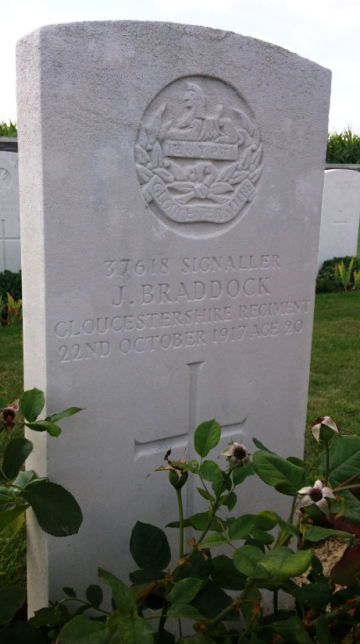
In the course of their quest for information the family had also obtained a copy, presumably from the Imperial War Museum or from the Regimental records office, of extracts from the so-called war diary of the Officer commanding the 14th Battalion describing the operations and action in which Joe was killed although of course he was not specifically named, given the huge number of casualties the regiment suffered at the time. This and all the other documents shared by David Bolsover are very informative in putting together the full story of the life and death of Joe Braddock. It is hoped that other readers of this newsletter might similarly share information they have on local history with our Archive group.






